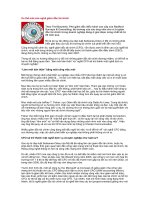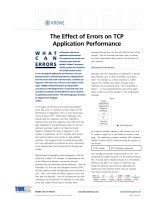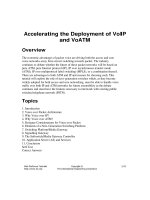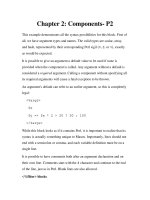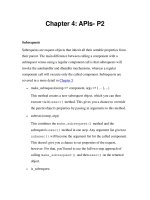Tài liệu PHP: The Good Parts: Delivering the Best of PHP- P2 doc
Bạn đang xem bản rút gọn của tài liệu. Xem và tải ngay bản đầy đủ của tài liệu tại đây (513.54 KB, 20 trang )
Table 1-1. Sampling of major websites that use PHP
Website name Description URL
Facebook Social networking
Flickr Photograph sharing
Wikipedia Online collaborative encyclopedia
SugarCRM Customer relationship management tool
Dotproject Project management tool
Drupal Website construction template engine
Interspire Newsletter and email marketing product
This is only the proverbial tip of the iceberg, and is not in any way meant to be an
exhaustive list; it is simply a short list of examples of what has been built with PHP. If
you have been to any of these websites, you can see what this powerful language can
accomplish.
Basic PHP Setup
By now you might be anxious to try PHP out for yourself, so we’ll go through a quick
installation discussion here and have you saying, “Hello, world” in no time.
The basic method of PHP development is to build PHP code on top of web server
software like Apache or IIS. There is a “stack” of software that is generally used for a
fully functional development environment: either LAMP or WAMP. LAMP stands for
Linux/Apache/MySQL/PHP, but there are variations to this, as one would expect. You
could be using PostgreSQL instead of MySQL for the database and therefore the acro-
nym would be LAPP, but you get the idea. The other acronym—WAMP—stands for
Windows/Apache/MySQL/PHP.
Typically, the OS has no real bearing on the functionality of the written
code. PHP written in the Windows environment will certainly operate
just as well on a Linux box and vice versa. The only thing to be cautious
of is if you are doing OS-level commands like CHMOD (for changing
file permissions) or CHOWN (for changing file ownerships) in Linux
and want to do the same in a different OS. Just be sure to test your code
well in this, and all, instances.
Since there are so many different platforms and components to setting up a full PHP
development environment, we won’t go into detail on how to establish that environ-
ment here. Be sure to go to for a full listing of the
latest stable releases for the many and varied platforms. There are also some all-in-one
installation packages for Windows; one is called XAMPP (X for cross-platform,
A for Apache, M for MySQL, P for PHP, and P for Perl), which can be found at
Basic PHP Setup | 3
Please purchase PDF Split-Merge on www.verypdf.com to remove this watermark.
After you have the package for
the appropriate platform, look for a file called install.txt among the downloaded files
for a setup guide.
Once you have PHP installed, you should be able to run a small script that will interpret
your php.ini settings file and show you all your directives and setting values. The code
for doing this is one line, like so:
<?php phpinfo() ; ?>
The way to start and stop PHP content is with the <?php text sequence and the ?> text
sequence, respectively, but more on that in the next chapter. For now, save this code
in your web root folder (usually www or htdocs) as phpinfo.php. When you enter http:
//localhost/phpinfo.php in the browser, the output should resemble Figure 1-1.
Take some time to review these settings, and don’t worry if you are not sure what most
of them are; simply having a screen that looks like Figure 1-1 is proof enough that PHP
is properly installed and being served through your localhost web server.
Localhost is the web address prefix for all the PHP code you write in
your
local computer environment. If you have code running off of a
remote server, you either reference it with a proper web address or a
specific IP number.
Now let’s write a little code here to do the proverbial worldwide greeting. Open a file
called HelloOutThere.php under the document root—typically, this is /var/www/ in
Linux or ../apache2/htdocs in Windows—and enter the following code:
<?php echo "Hello, is there anybody out there?" ; ?>
Then enter the following into the browser’s address field: http://localhost/HelloOut
There.php. The result should be a browser page similar to Figure 1-2.
What we are telling the web server to do here is to repeat (echo) something into the
browser’s display area. With the echo command, we can send a string of text or, as you
will see later in this book, almost anything within the web context. That’s all there is
to it. You have just created your first PHP web page.
4 | Chapter 1: The Good Parts
Please purchase PDF Split-Merge on www.verypdf.com to remove this watermark.
Figure 1-1. Result of phpinfo() function
Basic PHP Setup | 5
Please purchase PDF Split-Merge on www.verypdf.com to remove this watermark.
Figure 1-2. HelloOutThere.php example browser output
6 | Chapter 1: The Good Parts
Please purchase PDF Split-Merge on www.verypdf.com to remove this watermark.
CHAPTER 2
Casing the Joint
Now that you know the very basics of a PHP file, how to run it through a web server,
and how to display some content in a web browser, let’s look more closely at the lan-
guage’s building blocks and how you can use them to construct larger, more complex
websites and web applications. I call this process casing the joint because it involves
taking a basic cursory look at the PHP environment to get a better handle on the basics
of a PHP code file. The mastery of the building blocks you will be exposed to in this
chapter will stand you in good stead, so be sure that you have a strong understanding
of them and that you know how and when to use them. Initially, we will look at small
segments of a PHP code file (like variables and types of data), and then we will discuss
how to control the outcome of a request with the use of decision-making code, also
known as flow control. Finally, we will explore some concepts that explain the overall
environment of a PHP application: where items are placed in memory (server versus
client) and how to retrieve information from those areas.
Whitespace, Comments, and Basic Syntax
As far as PHP is concerned, whitespace is ignored when code is sent to the interpreter.
This means that all comments and blank lines are effectively stripped out of the code
file as it is running.
If you’re trying to achieve microoptimization and want to send some
really clean code to the interpreter so that it doesn’t have to take time
to strip out all the whitespace, look into the PHP function called
php_strip_whitespace
. This function will scan over a code file when
provided with the filename, and will clean out all the comments and
blank lines, returning the cleaned-out file to you for saving.
7
Download at Wow! eBook
Please purchase PDF Split-Merge on www.verypdf.com to remove this watermark.
If you look at the following code example, you will see many whitespace specimens:
1<?php
2 # this is a PHP comment line
3
4 /*
5 * this is a multi-line PHP
6 * comment block
7 */
8
9 echo "Hello my good web browser" ; // an inline code comment
10
11
12
13 ?>
Line
1 may or may not have some whitespace in it. If you add spaces (by pressing the
spacebar) after the opening PHP tag, that would be considered whitespace.
All of line 2 is considered whitespace because it is a comment line. Comment lines are
notes about the code that are not executed by the PHP interpreter. Lines 4 to 7 are
comments as well, but are of a different type. They are known as multiline comment
blocks and, as you can see, they begin with a /* combination and terminate with the
reverse */ combination. The PHP interpreter considers these four lines as nonexecut-
able code, and essentially treats it as whitespace, skipping it entirely.
Line 9 is executable, yet it also has an inline comment, signified by the // combination.
PHP interprets the comment section first, ignoring it. In fact, the comment can even
come between the end of the code and the placement of the semicolon, but that could
add confusion to the readability of your code (you will become great friends with the
semicolon character as you become more experienced with PHP, because it marks the
end of all PHP commands—you will get a syntax error if any are missing).
Lines 3, 8, and 10–12 are empty lines within the file and therefore are neither comments
nor executable code. Consequently, they are also considered whitespace. If we removed
all the whitespace from this sample it would look like the following:
1<?php echo "Hello my good web browser" ; ?>
As you can see, there is some need for small amounts of whitespace between the dif-
ferent commands so that PHP can make necessary distinctions. Also, it is good to note
that comments certainly have their place in making the code more human-readable.
After all, humans have to read and understand your code in order to maintain it. You
can create a comment within a PHP code file using any of the following:
#
Use this method to indicate an inline comment. You cannot include any executable
code on the same line.
//
Use this method to indicate an inline comment. This can appear on its own line of
code or added at the end of an executable line.
8 | Chapter 2: Casing the Joint
Please purchase PDF Split-Merge on www.verypdf.com to remove this watermark.
/* ... */
This indicates a multiline comment block. Do not place any executable code within
this block of text.
So, the basic syntax of a PHP statement includes an opening PHP designation tag
[<?php or <?] and a closing tag [?>]. These tags allow the web server to determine which
portions of the file should be handed over to PHP.
Use of the shorter open tag format <? has depreciated and only works
in PHP 5 if the short_open_tag directive is enabled. It is much better
practice to use the full open tag <?php wherever possible.
After this combination of tags, you can begin adding PHP programming statements.
You can use one of four different language constructs: statements like the echo com-
mand, function calls (either from a PHP library or one of your own), flow control
statements (if... else...), or comments. PHP applications are built on these four simple
constructs and, naturally, an entire web application will make use of all of them in large
quantities. Additionally, you can define object-oriented classes in PHP (see Chapter 6).
You can also use other combinations of the building blocks of PHP, like variables, to
make the application much more robust. Let’s take a look at variables and how you
can use them.
Variables: Data Types, Loose Typing, and Scope
Variables can hold different kinds of data, but they are always established the same
way. Use the following rules when defining a PHP variable:
$
Variable names have to begin with a dollar sign ($).
Case-sensitive
The name of a variable is case-sensitive, so $firstname is a completely different
variable than $FirstName.
Letter or underscore
After the dollar sign, the next character in the name must be a letter or an under-
score; after this, the remainder of the variable name can be any combination of
letters, numbers, and underscores.
$this
The variable named $this is reserved for use in Object Oriented PHP, so it can’t
be used elsewhere.
A data type is simply that: a type of data. These types come with various restrictions
on the structure, interpretation, or operations that may be performed on the data. In
Variables: Data Types, Loose Typing, and Scope | 9
Please purchase PDF Split-Merge on www.verypdf.com to remove this watermark.
PHP, there are eight basic (or primitive) variable types; other types may be defined, but
we will only be looking at these eight within the scope of this book. The primitive types
are categorized in segments: scalar, compound, and special. Table 2-1 shows these types
and segments, and gives some examples.
Table 2-1. PHP data types
Segment Type Description/example
Scalar types Boolean Logical TRUE or FALSE
Integer Whole numbers: e.g., 1, 15, –122, and 967967
Float (double) Numbers with decimal notations (usually seen in financial situations): e.g., 12.56 or 345.456
String Characters, letters, or numbers (usually defined within double quotes): e.g., “Hello there”
or “123AvR”
Compound
types
Array A collection of keys with their values, arrays can hold other arrays (multidimensional); see
Chapter 5 for more detail
Object The basics for class definitions and object-oriented programming; see Chapter 6 for more
detail
Special types NULL Defines a variable with no value; the variable exists, but contains nothing (not an empty
string, not the value 0, nothing)
Resource Stores a reference to functions, databases, files, or other resources outside of PHP
There are two ways to assign values to variables: by value and by reference. The typical
way to do assignments is to define by value. For example, in $firstname = "Peter", we
are assigning the entire string of five characters to the variable called $firstname, and
that value will remain intact until it is reassigned or the script has completed. Nothing
else can affect that variable content unless the program directly interacts with it.
The reference approach allows the same variable content to use different names, and
allows a function to affect a variable that is not part of that function. Only variables
previously defined by value can be defined by reference. However, once a variable is
assigned by reference, it is tied to its referenced variable; if the content of one of the
referenced variables changes, all the local copies of that referenced variable are auto-
matically updated with the new content. To define a variable by reference, simply prefix
the referenced variable with the ampersand (&) character. The following code sample
shows this in effect:
<?php
$firstname = "Peter" ; // assigned by value
$fname = &$firstname ;
// $firstname is assigned to $fname by reference.
echo $fname . "<br/>"; // Peter is displayed
$fname = "Dawn"; // change referenced value
echo $firstname . "<br/>"; // Dawn is displayed, not Peter,
// because of the "by reference"
?>
10 | Chapter 2: Casing the Joint
Please purchase PDF Split-Merge on www.verypdf.com to remove this watermark.
